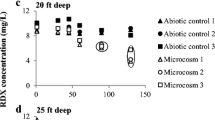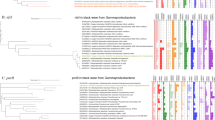Abstract
This study compares three molecular techniques, including terminal restriction fragment length polymorphism (T-RFLP), RFLP analysis with clone sequencing, and quantitative PCR (Q-PCR) for surveying differences in microbial communities at two contaminated field sites that exhibit dissimilar chlorinated solvent degradation activities. At the Idaho National Engineering and Environmental Laboratory (INEEL), trichloroethene (TCE) was completely converted to ethene during biostimulation with lactate. At Seal Beach, California, perchloroethene (PCE) was degraded only to cis-dichloroethene (cDCE) during biostimulation but was degraded to ethene after bioaugmentation with a dechlorinating culture containing Dehalococcoides strains. T-RFLP analysis showed that microbial community composition differed significantly between the two sites, but was similar within each site among wells that had low or no electron donor exposure. Analysis of INEEL clone libraries by RFLP with clone sequencing revealed a complex microbial population but did not identify any Dehalococcoides strains. Q-PCR targeting the 16S rRNA gene of Dehalococcoides strains – known for their unique capability to dechlorinate solvents completely to ethene – revealed a significant population at INEEL, but no detectable population at Seal Beach prior to bioaugmentation. Detection of Dehalococcoides by Q-PCR correlated with observed dechlorination activity and ethene production at both sites. Q-PCR showed that Dehalococcoides was present in even the pristine well at INEEL, suggesting that the difference in dechlorination ability at the two sites was due to the initial absence of this genus at Seal Beach. Of the techniques tested, Q-PCR quantification of specific dechlorinating species provided the most effective and direct prediction of community dechlorinating potential.
Similar content being viewed by others
References
Adrian L, Szewzyk U, et al, (2000) Bacterial dehalorespiration with chlorinated benzenes Nature 408: 580–583
Altschul SF, Gish W, et al, (1990) Basic Local Alignment Search Tool J. Mol. Bio. 215(3): 403–410
Benson DA, Karsch-Mizrachi I, et al, (2000). Genbank Nucleic Acids Res. 28(1): 15–18
Christensen J, Stencil J, et al, (2003) Rapid identification of bacteria from positive blood cultures by terminal restriction fragment length polymorphism profile analysis of the 16S rRNA gene J. Clin. Microbiol. 41(8): 3790–3800
Cole JR, Chai B, et al, (2005) The Ribosomal Database Project (RDP-II): sequences and tools for high-throughput rRNA analysis Nucleic Acids Res. 33(Database Issue): D294-D296
Cupples AM, Spormann AM, et al, (2003) Growth of a Dehalococcoides-like microorganism on vinyl chloride and cis-dichloroethene as electron acceptors as determined by competitive PCR Appl. Environ. Microbiol. 69(2): 953–959
Dojka MA, Hugenholtz P, et al, (1998) Microbial diversity in a hydrocarbon- and chlorinated-solvent-contaminated aquifer undergoing intrinsic bioremediation Appl. Environ. Microbiol. 64(10): 3869–3877
Drake HL (1994) Acetogenesis, Acetogenic Bacteria, and the Acetyl-CoA “Wood/Ljungdahl” Pathway: Past and Current Perspectives. Chapman and Hall, New York
Duhamel M, Wehr S, et al, (2002) Comparison of anaerobic dechlorinating enrichment cultures maintained on tetrachloroethene, trichloroethene, cis-dichloroethene and vinyl chloride Water Res. 36(17): 4193–4202
El Fantroussi S, Naveau H, et al, (1998) Anaerobic dechlorinating bacteria Biotechnol. Progr. 14(2): 167–188
Fennell DE, Gossett JM, et al, (1997) Comparison of butyric acid, ethanol, lactic acid, and propionic acid as hydrogen donors for the reductive dechlorination of tetrachloroethene Environ. Sci. Technol. 31(3): 918–926
French JH, Rossi A, et al. (2003) Phased in situ biostimulation/bioaugmentation pilot testing in a coastal aquifer. Proceedings of the 8th International In Situ and On-Site Bioremediation Symposium
Godsy E, Warren E, et al, (2003) The role of microbial reductive dechlorination of TCE at a phytoremediation site Int. J. Phytoremediat. 5(1): 73–87
He J, Ritalahti K, et al, (2003) Complete detoxification of vinyl chloride by an anaerobic enrichment culture and identification of the reductively dechlorinating population as a Dehalococcoides species Appl. Environ. Microbiol. 69(2): 996–1003
He J, Ritalahti K, et al, (2003) Detoxification of vinyl chloride to ethene coupled to growth of an anaerobic bacterium Nature 424(6944): 62–65
Hendrickson ER, Payne JA, et al, (2002) Molecular analysis of Dehalococcoides 16S ribosomal DNA from chloroethene-contaminated sites throughout North America and Europe Appl. Environ. Microbiol. 68(2): 485–495
Holliger C, Schraa G, et al, (1993) A highly purified enrichment culture couples the reductive dechlorination of tetrachloroethene to growth Appl. Environ. Microbiol. 59(9): 2991–2997
Lash L, (2000) Metabolism of trichloroethylene Environ. Health Persp. 108: 177–200
Lee MD, Odom JM, et al, (1998) New perspectives on microbial dehalogenation of chlorinated solvents: insights from the field Annu. Rev. Microbiol. 52: 423–452
Lendvay JM, Loffler FE, et al, (2003) Bioreactive barriers: a comparison of bioaugmentation and biostimulation for chlorinated solvent remediation Environ. Sci. Technol. 37(7): 1422–1431
Liu WT, Marsh TL, et al, (1997) Characterization of microbial diversity by determining terminal restriction fragment length polymorphisms of genes encoding 16S rRNA Appl. Environ. Microbiol. 63(11): 4516–4522
Macbeth TW, Cummings DE, et al, (2004) Molecular characterization of a dechlorinating community resulting from in situ biostimulation in a TCE-contaminated deep fractured basalt aquifer and comparison to a derivative laboratory culture Appl. Environ. Microbiol. 70(12): 7329–7341
Major D, McMaster M, et al, (2002) Field demonstration of successful bioaugmentation to achieve dechlorination of tetrachloroethene to ethene Environ. Sci. Technol. 36(23): 5106–5116
Maymo-Gatell X, Chien Y, et al, (1997) Isolation of a bacterium that reductively dechlorinates tetrachloroethene to ethene Science 276: 1568–1571
Mills DK, Fitzgerald K, et al, (2003) A comparison of DNA profiling techniques for monitoring nutrient impact on microbial community composition during bioremediation of petroleum-contaminated soils J. Microbiol. Methods 54(1): 57–74
Panaro NJ, Yuen PK, et al, (2000) Evaluation of DNA fragment sizing and quantification by the Agilent 2100 bioanalyzer Clin. Chem. 46(11): 1851–1853
Puls RW & Barcelona MJ (1996) Low-flow (minimal drawdown) ground-water sampling procedures. Office of Research and Development and Office of Solid Waste and Emergency Response
Richardson RE, Bhupathiraju VK, et al, (2002) Phylogenetic characterization of microbial communities that reductively dechlorinate TCE based upon a combination of molecular techniques Environ. Sci. Technol. 36(12): 2652–2662
Rogers G, Hart C, et al, (2003) Bacterial diversity in cases of lung infection in cystic fibrosis patients: 16S ribosomal DNA (rDNA) length heterogeneity PCR and 16S rDNA terminal restriction fragment length polymorphism profiling J. Clin. Microbiol. 41(8): 3548–3558
Seshadri R, Adrian L, et al, (2005) Genome sequence of the PCE-dechlorinating bacterium Dehalococcoides ethenogenes Science 307(5706): 105–108
Smits THM, Devenoges C, et al, (2004) Development of a real-time PCR method for quantification of the three genera Dehalobacter, Dehalococcoides, and Desulfitobacterium in microbial communities J. Microbiol. Methods 57(3): 369–378
Song DL, Conrad ME, et al, (2002) Stable carbon isotope fractionation during enhanced in situ bioremediation of trichloroethene Environ. Sci. Technol. 36(10): 2262–2268
Sorenson KS, Peterson LN, et al, (2000) An evaluation of aerobic trichloroethene attenuation using first-order rate estimation Bioremediation J. 4(4): 337–357
Takai K, Mormile M, et al, (2003) Shifts in archaeal communities associated with lithological and geochemical variations in subsurface Cretaceous rock Environ. Microbiol. 5(4): 309–320
Watts JE, Wu Q, et al, (2001) Comparative analysis of polychlorinated biphenyl-dechlorinating communities in enrichment cultures using three different molecular screening techniques Environ. Microbiol. 3(11): 710–719
Acknowledgments
We thank Vishvesh Bhupathuraju and Kimberlee West for technical assistance. Sampling and chemical analysis at the TAN site was funded by the U.S. Department of Energy through Idaho Operations Office contract DE-AC07-99ID13727. Sampling and analyses at Seal Beach were supported by the Naval Facilities Engineering Command, Southwest Division, and by Bechtel Environmental, Inc. Additional support was provided by the National Science Foundation under Grant No. 0104740 and the Superfund Basic Research Project under NIEHS ES04705.
Author information
Authors and Affiliations
Corresponding author
Rights and permissions
About this article
Cite this article
Rahm, B.G., Chauhan, S., Holmes, V.F. et al. Molecular characterization of microbial populations at two sites with differing reductive dechlorination abilities. Biodegradation 17, 523–534 (2006). https://doi.org/10.1007/s10532-005-9023-9
Accepted:
Published:
Issue Date:
DOI: https://doi.org/10.1007/s10532-005-9023-9




